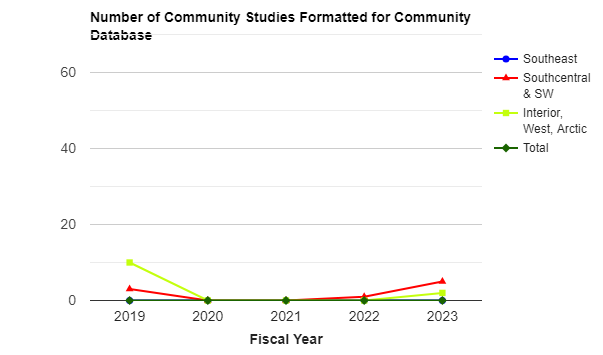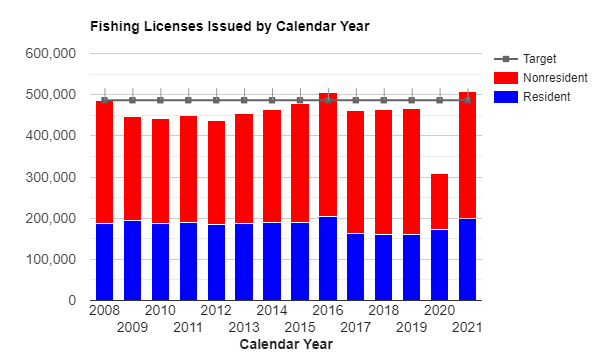Key Performance Indicators
Department of Fish and Game
Mission
To protect, maintain, and improve the fish, game, and aquatic plant resources of the state, and manage their use and development in the best interest of the economy and the well-being of the people of the state, consistent with the sustained yield principle. Alaska Constitution Article 8, Sec. 4; Alaska Statute (AS) 16.05.020(2)
Key Performance Indicators
| FY2024 Management Plan as of 04/25/2024 (in thousands) | |||||||||
| Department of Fish and Game Totals | Funding | Positions | |||||||
| UGF Funds | DGF Funds | Other Funds | Federal Funds | Total Funds | Full Time | Part Time | Non Perm | ||
| $65,292.4 | $13,121.4 | $75,911.2 | $88,577.5 | $242,902.5 | 829 | 593 | 1 | ||
| ||||||||||||||||||||||||||
| 2: |
Stock Assessment and Research
Ensure sustainability and harvestable surplus of fish and wildlife resources: improve existing fish and wildlife stock assessment and research capabilities; expand stock assessments; invest in new technologies; anticipate changing conditions (e.g., climate change, invasive species). |
Funding | Positions | ||||||
|
UGF Funds |
DGF Funds |
Other Funds |
Federal Funds |
Total Funds |
Full Time |
Part Time |
Non Perm |
||
| $24,756.0 | $7,506.5 | $20,294.7 | $21,638.0 | $74,195.2 | 248 | 238 | 0 | ||
- Target: Achieve salmon escapement goals in 80% of monitored systems.
- Target: Update and maintain the Community Subsistence Information System (CSIS), an online public information resource, by including all studies completed during the fiscal year.
| 3: |
Customer Service and Public Involvement
Provide accurate/meaningful info to all customers and involve the public in management of fish/wildlife resources: enhance public communications materials/delivery; improve Boards of Fisheries and Game and other regulatory processes; increase publication in scientific literature; improve management/scientific reporting; improve licensing/permitting |
Funding | Positions | ||||||
|
UGF Funds |
DGF Funds |
Other Funds |
Federal Funds |
Total Funds |
Full Time |
Part Time |
Non Perm |
||
| $9,515.7 | $510.0 | $17,344.2 | $19,630.3 | $47,000.2 | 155 | 83 | 0 | ||
- Target: To sustain growth in online renewal revenue.
- Target: Evaluate the number of transfers processed during the calendar year by type.
- Target: Increase sales of hunting and trapping licenses to the three-year average.
- Target: Return sport fishing license sales and revenue collection to 2008 levels to ensure excellence in fisheries management and research for the benefit of sport anglers, the state"s economy, and future generations of Alaskans.
- Target: To complete the limitation of all 68 limited fisheries.
Performance Detail
| Priority 1: Management |
Target #2: Maintain total annual value of commercial harvests at over $1 billion annually..
Target Last Modified: 10/23/2023 |
Target #3: Enhance angler opportunity by meeting annual projections for number of fish and number of locations stocked as indicated in the Division"s updates to the Statewide Stocking Plan..
Related links: |
| Priority 2: Stock Assessment and Research |
Target #1: Achieve salmon escapement goals in 80% of monitored systems..
The division annually deploys and operates numerous weirs, counting towers, and sonar sites to conduct escapement counts. Aerial and foot surveys are also used extensively in the absence of other means of counting escapement. In 2016, there were 287 salmon escapement goals in Alaska. Of the stocks with goals, 242 were adequately assessed in 2016 and of those, 72% met or exceeded their escapement goal. For Chinook salmon, there are currently 66 stock specific goals. Despite improvements in meeting Chinook salmon escapement goals statewide since 2012, 2016 saw a decrease to 54%. For pink salmon, there are currently 38 escapement goals in even years. In 2016, only 47% of the pink salmon goals were met or exceeded. There was a decrease in percentage of meeting escapement goals for sockeye, chum and coho salmon as well, but not to the extent of Chinook or pink salmon. For sockeye salmon, 86% of the goals were met -down 1% from 2015. For chum salmon, 77% of the goals were met. Target Last Modified: 03/29/2023 |
Target #2: Update and maintain the Community Subsistence Information System (CSIS), an online public information resource, by including all studies completed during the fiscal year..
In FY2020, the onset of the global COVID-19 pandemic, and subsequent restrictions and closures imposed to protect public health and safety during the worldwide Covid-19 pandemic significantly affected the section"s normal research activities. Reports and data graphs reflect the loss of data collection. Analysis was delayed until 2022 for all projects launched in 2021 due to the pivot to work affected by the pandemic restrictions. Fieldwork conducted in FY2022 will be reflected in FY2023 data. Related links: Target Last Modified: 11/14/2023 |
| Priority 3: Customer Service and Public Involvement |
Target #1: To sustain growth in online renewal revenue..
Target Last Modified: 03/29/2023 |
Target #2: Evaluate the number of transfers processed during the calendar year by type..
Target Last Modified: 03/29/2023 |
Target #3: Increase sales of hunting and trapping licenses to the three-year average..
The most common resident license is the Hunt/Sport Fish license. One incentive for hunters and trappers to buy licenses is confidence that game populations are abundant and that there are good opportunities to hunt and harvest game. The increased number of resident hunters may be a direct result of our Hunter Education program activities. Non-resident numbers likely reflect the state of the economy, as well as increased energy and airfare costs. In the 2016 legislative session HB137 was passed to increase license fees for both resident and non-resident hunters and fishermen. The increase became effective on 1/1/17, however 2017 licenses were available for purchase well before that date. As a result hunters were able to purchase their 2017 licenses at the reduced 2016 rate. This resulted in a spike of license purchases in 2016. Related links: |
Target #4: Return sport fishing license sales and revenue collection to 2008 levels to ensure excellence in fisheries management and research for the benefit of sport anglers, the state"s economy, and future generations of Alaskans..
Related links: |
Target #5: To complete the limitation of all 68 limited fisheries..
Target Last Modified: 03/29/2023 |
Last refreshed: 04/25/2024 05:00 pm










